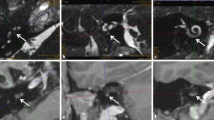Abstract
Objective
To define a new surgical option, with lower morbidity, for the treatment of intralabyrinthine schwannomas.
Study design
Retrospective case review.
Setting
Tertiary referral centers.
Patients
Eight patients affected by an intralabyrinthine schwannoma, with or without extension to the internal auditory canal, that underwent surgery with a transcanal transpromontorial approach, were included in the study. The average age at presentation was 47 years. Patients’ characteristics, symptoms, tumor features, and surgical results were analyzed.
Interventions
All patients were diagnosed and evaluated pre-operatively with high-resolution, gadolinium-enhanced MRI and CT scan of the temporal bone, and underwent surgery via either transcanal transpromontorial endoscopic approach (TTEA) or enlarged transcanal transpromontorial endoscopic approach (ETTA).
Main outcome measures
Hearing function was evaluated with the Hearing Classification System according to the Committee on Hearing and Equilibrium Guidelines. Facial nerve function was evaluated using the House–Brackmann grading system (HB).
Results
In six patients out of eight, a TTEA was performed, whereas, due to the extension of the pathology to the cerebellopontine angle, two patients underwent an ETTA. The mean follow-up period was 15.5 months (range 1–69). No intra-operative and post-operative major complications were observed. Post-operative facial nerve function was normal in seven out of eight patients (grade I HB). One patient presented a grade II HB.
Conclusion
The endoscopic approach to cochlear schwannoma represents a good treatment option for patients and should be preferred to other more invasive surgical techniques when indicated, to reduce complications, hospitalization, and offer to patients the chance to eradicate the disease, thus avoiding the stress of a long-life radiological follow-up.
Level of evidence
4.



Similar content being viewed by others
References
Bouchetemble P et al (2013) Intralabyrinthine schwannomas: a case series with discussion of the diagnosis and management. Otol Neurotol 34(5):944–951
Brian A, Neff TOW Jr, Sataloff RT (2003) Intralabyrinthine schwannomas. Otol Neurotol 24:299–307
Salzman KL et al (2012) Intralabyrinthine schwannomas: imaging diagnosis and classification. AJNR Am J Neuroradiol 33(1):104–109
Kennedy RJ et al (2004) Intralabyrinthine schwannomas: diagnosis, management, and a new classification system. Otol Neurotol 25(2):160–167
Anonymous (1995) Committee on Hearing and Equilibrium Guidelines for the evaluation of hearing preservation in acoustic neuroma (vestibular schwannoma). American Academy of Otolaryngology-Head and Neck Surgery Foundation. INC. Otolaryngol Head Neck Surg 113(3):179–180
House JW, Brackmann DE (1985) Facial nerve grading system. Otolaryngol Head Neck Surg 93(2):146–147
Presutti L et al (2017) Expanded transcanal transpromontorial approach to the internal auditory canal: pilot clinical experience. Laryngoscope 127(11):2608–2614
Hoistad DL et al (2001) Update on conservative management of acoustic neuroma. Otol Neurotol 22(5):682–685
Mirz F et al (1999) Investigations into the natural history of vestibular schwannomas. Clin Otolaryngol Allied Sci 24(1):13–18
Stangerup SE et al (2004) Increasing annual incidence of vestibular schwannoma and age at diagnosis. J Laryngol Otol 118(8):622–627
Karpinos M et al (2002) Treatment of acoustic neuroma: stereotactic radiosurgery vs. microsurgery. Int J Radiat Oncol Biol Phys 54(5):1410–1421
Shaw EG, Coffey RJ, Dinapoli RP (1995) Neurotoxicity of radiosurgery. Semin Radiat Oncol 5(3):235–245
Leksell L (1983) Stereotactic radiosurgery. J Neurol Neurosurg Psychiatry 46(9):797–803
Leksell DG (1987) Stereotactic radiosurgery. Present status and future trends. Neurol Res 9(2):60–68
Doyle KJ, Brackmann DE (1994) Intralabyrinthine schwannomas. Otolaryngol Head Neck Surg 110(6):517–523
Lee JJ et al (2015) Recovery of hearing after surgical removal of intralabyrinthine schwannoma. Laryngoscope 125(8):1968–1971
Mazzoni A et al (2017) Acoustic schwannoma with intracochlear extension and primary intracochlear schwannoma: removal through translabyrinthine approach with facial bridge cochleostomy and transcanal approach. Eur Arch Otorhinolaryngol 274(5):2149–2154
Mahboubi H et al (2014) Complications of surgery for sporadic vestibular schwannoma. Otolaryngol Head Neck Surg 150(2):275–281
Coca A, Gómez JR, Llorente JL, Rodrigo JP, Núñez F, Sevilla MA et al (2007) Complicaciones y secuelas en la cirugía de los neurinomas del acústico. Acta Otorrinolaringol Esp 58:470–475
Marchioni D et al (2015) Endoscopic transcanal corridors to the lateral skull base: initial experiences. Laryngoscope 125(Suppl 5):S1–S13
Wick CC, Arnaoutakis D, Barnett SL, Rivas A, Isaacson B (2017) Endoscopic transcanal transpromontorial approach for vestibular schwannoma resection: a case series. Otol Neurotol 38(10):490–495
Presutti L et al (2017) Expanded transcanal transpromontorial approach to the internal auditory canal and cerebellopontine angle: a cadaveric study. Acta Otorhinolaryngol Ital 37(3):224–230
Funding
The present authors have no financial relationship to disclose.
Author information
Authors and Affiliations
Contributions
All of the authors have read and approved the manuscript.
Corresponding author
Ethics declarations
Conflict of interest
None of the authors has conflicts of interest to declare.
Ethical approval
All procedures performed in studies involving human participants were in accordance with the ethical standards of the institutional and/or national research committee and with the 1964 Helsinki declaration and its later amendments or comparable ethical standards. This article does not contain any studies with animals performed by any of the authors.
Informed consent
Informed consent was obtained from all individual participants included in the study.
Rights and permissions
About this article
Cite this article
Marchioni, D., De Rossi, S., Soloperto, D. et al. Intralabyrinthine schwannomas: a new surgical treatment. Eur Arch Otorhinolaryngol 275, 1095–1102 (2018). https://doi.org/10.1007/s00405-018-4937-0
Received:
Accepted:
Published:
Issue Date:
DOI: https://doi.org/10.1007/s00405-018-4937-0




